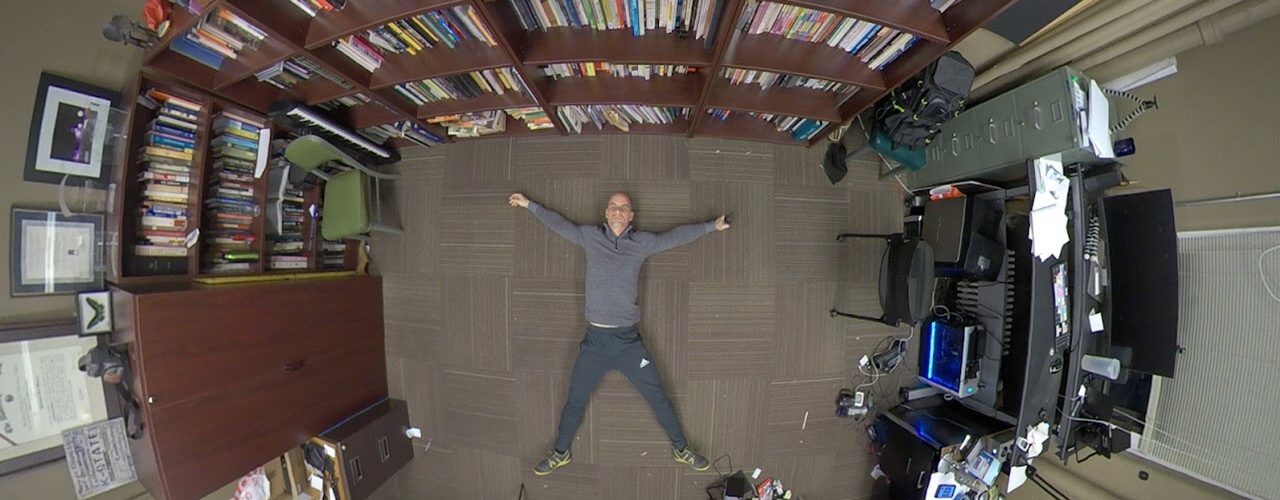This is how I spent most of my first year teaching online.
Like nearly every other faculty member in the world, I had to quickly transform my class from in-person to online. As for many others, this was my quintessential dystopian nightmare. Everything I loved most about teaching was suddenly taken away. The only difference between me and nearly every other faculty member in the world, is that it happened to me four years ago. With just a week of prep time to transition, I stared into the abyss of the lifeless webcam on Day 1 and thought everything I loved about teaching and perhaps my life as a teacher was coming to an end. It turned out to be just the beginning of something far more wonderful than I could have ever imagined. Here are three things I learned about online teaching that helped me find joy and adventure in my teaching again.
#1. Connect. Don’t perform.
I knew I would have to get on camera to make the class work, but I hated being on camera. I spent days recording my first 5 minute video. I couldn’t get through one sentence without stumbling over words. I tried reading a script, but I looked stiff and scared. No matter what I tried I looked so flat and lifeless on camera – nothing like how I imagined myself in the classroom.
The breakthrough finally came when I made my first super simple video describing three things about myself and asked my students to do the same. As the student videos poured in, I found that I didn’t care if they stumbled over their words or had bad lighting. I simply loved the humanity of each and every video, and the next time I looked into the camera I stopped seeing my inevitable failures.
In fact, I stopped thinking about myself and my performance entirely, which of course made my performance much better! It wasn’t about me anymore. It was about them. I started connecting, not performing, looking right past the camera, imagining my students and feeling a little bit of that communion I once thought could only be felt in the classroom.
#2. High impact videos do not have to be High Tech.
Over the next four years I completely immersed myself in the art of video creation, watching hundreds of hours of YouTube tutorials, experimenting with every style imaginable, and oftentimes lying on the floor in despair realizing just how hard it is to make good videos. Over the years, I have developed a style I am proud of, and I have come to love the entire video-editing process, but I wish I would have known early on that the high-production-value videos I aspired to make were not the videos that my students would appreciate the most.
#3. Online does not have to mean “on the screen.”
We are all so tired of screens. The right approach to online teaching can set you and your students free. I love making videos, but I keep my videos short and create all of my longform content as podcasts. In fact, I provide a single downloadable mp3 every week with all of the class material on it. More than anything else I do, this is what my students say they appreciate the most. It helps them work learning into their busy lives. They can listen while they commute, workout, go for a walk, or do the laundry. Paired with assignments that get them out into the world, an online class can become a welcome relief from the screen.
My New Classroom: The World
When Covid started to rage across the world in February, I was living a dream life of teaching I could have never imagined for myself just 4 years ago. I was traveling the world, making videos about the world’s religions for my students. They are not high-production Netflix originals. They are just me filming my real encounters with real people who happen to be really different from me. I don’t use fancy cameras – just a GoPro and a small Sony pocket camera. This way of teaching is not only joyful and adventurous, it is also effective in ways that are difficult to emulate in the traditional classroom. Out in the world I am able to show my students what I could only tell them about before – not just a more raw and lively look at different religions – but the much more important implicit messages I hope to pass on.
Upon reflection, I realize now that it has always been these “implicit messages” that were most important to me. I care less about whether or not they can analytically distinguish between multiple forms of Buddhism and much more about their interest and ability to build authentic friendships with people who believe differently than they do. I want to model and inspire them to take on the long arduous process of breaking down their biases and nurturing up their skills in empathy and understanding to build those friendships. These implicit messages we hope to pass on – the very heart of the “disciplines” we teach – are not simply “facts” to be memorized for an exam. They have to be lived and experienced, and “online learning” has shown me new ways to do this that will forever change the way I teach, online and off.
Me (left) with my immediate family and my extended family in a Papua New Guinea village where I was “teaching online” in January (making videos for my students.) We have shared over 1,000 meals together over 20+ years of fieldwork.

Author
Michael Wesch
Professor of Anthropology, Kansas State University














